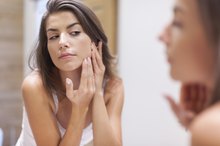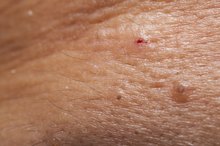What Is the Difference Between Clogged Pores & Acne?
Clogged pores and acne are two different skin conditions. While acne doesn't occur without pores first being clogged, clogged pores alone don't necessarily lead to acne. Clogged pores are caused by a combination of dead skin cells, dirt and excessive sebum, which are natural oils produced by the sebaceous glands. Acne, on the other hand, requires all these factors, plus a bacterial infection 3. Without this infection, clogged pores can create other skin conditions, none of which always lead to acne.
Skin Conditions Caused by Clogged Pores
Clogged pores can cause blackheads -- overstretched hair follicles plugged with dead skin cells and sebum. The overstretched follicle allows air to mix with the sebum and dirt, causing a chemical reaction that turns the follicle black. Whiteheads are also caused by clogged pores, but unlike blackheads, the follicles are not stretched, leaving no room for air to enter the follicle for a chemical reaction to occur. Whiteheads occur under the skin, while blackheads occur on the skin.
- Clogged pores can cause blackheads -- overstretched hair follicles plugged with dead skin cells and sebum.
- Whiteheads are also caused by clogged pores, but unlike blackheads, the follicles are not stretched, leaving no room for air to enter the follicle for a chemical reaction to occur.
Clogged Pores Set the Stage for Acne
Why Does Pus From Acne Have an Odor?
Learn More
Acne is caused by a combination of clogged pores, excessive production of sebum and an infection by one of six strains of Propionibacterium acnes, a family of bacteria naturally found on the skin. While there are 11,000 strains of this bacteria, some of the strains are beneficial to keeping skin healthy; only six strains have been found consistently on acne-prone skin. **When excessive oil clogs pores, it creates a breeding ground for the acne-causing strains of bacteria 3. The body's attempt to fight the resulting bacterial infection leads to inflammation, which then turns into acne.
- Acne is caused by a combination of clogged pores, excessive production of sebum and an infection by one of six strains of Propionibacterium acnes, a family of bacteria naturally found on the skin.
- When excessive oil clogs pores, it creates a breeding ground for the acne-causing strains of bacteria 3.
Clearing Up Clogged Pores
In the instance where clogged pores exist absent whiteheads or blackheads, it's best to clean up the skin before conditions turn worse. Cleansers made with salicylic acid are useful for removing dirt and excessive oil. A good exfoliant can get rid of dead skin before it clogs pores. Apple cider vinegar makes a good natural exfoliant -- just soak a cotton pad and wipe a thin layer across your skin after washing your face with a regular cleanser.
- In the instance where clogged pores exist absent whiteheads or blackheads, it's best to clean up the skin before conditions turn worse.
- A good exfoliant can get rid of dead skin before it clogs pores.
When Acne Appears
How to Best Treat an Underground Pimple
Learn More
Despite the most meticulous cleansing regimen, clogged pores can still turn into acne as bacteria festers under the skin 3. When this happens, it's best not to pick at the resulting pimple, as this will only drive the bacteria deeper into the skin. Topical creams containing benzoyl peroxide or retinols are often effective in killing the bacteria, unclogging oil glands and healing pimples. For severe acne, consult a dermatologist, who may prescribe bacteria-killing antibiotics.
- Despite the most meticulous cleansing regimen, clogged pores can still turn into acne as bacteria festers under the skin 3.
- When this happens, it's best not to pick at the resulting pimple, as this will only drive the bacteria deeper into the skin.
Related Articles
References
- Palo Alto Medical Foundation: Acne
- Columbia University Student Health Center: Acne
- Scientific American: Does 1 Type of Bacteria Cause Acne?: Zit All Depends
- Flament F, Francois G, Qiu H, et al. Facial skin pores: a multiethnic study. Clin Cosmet Investig Dermatol. 2015;8:85–93. Published 2015 Feb 16. doi:10.2147/CCID.S74401
- Maia Campos PMBG, Melo MO and Mercurio DG (2019) Use of Advanced Imaging Techniques for the Characterization of Oily Skin. Front. Physiol. 10:254. doi: 10.3389/fphys.2019.00254
- Makrantonaki E, Ganceviciene R, Zouboulis C. An update on the role of the sebaceous gland in the pathogenesis of acne. Dermatoendocrinol. 2011;3(1):41–49. doi:10.4161/derm.3.1.13900
- Flament F, Francois G, Qiu H, et al. Facial skin pores: a multiethnic study. Clinical, Cosmetic and Investigational Dermatology. 2015;8:85-93. doi:10.2147/CCID.S74401
- Zaenglein AL, Pathy AL, Schlosser BJ, et al. Guidelines of care for the management of acne vulgaris. J Am Acad Dermatol. 2016;74(5):945-73.e33. doi:10.1016/j.jaad.2015.12.037
- Keri J. Acne. Merck Manual Consumer Version. Updated December 2018.
- Keri J. Acne Vulgaris. Merck Manual Professional Version. Updated December 2018.
- Harper J. 10 Things to Try When Acne Won’t Clear. American Academy of Dermatology.
- Cleveland Clinic. Acne. Updated March 22, 2017.
- Cleveland Clinic. Isotretinoin capsules.
- Lavers I. Therapeutic strategies for acne vulgaris. Nurs Times. 2013;109(48):16-8.
Writer Bio
Lilian M Raji is a strategic marketing and public relations adviser for luxury lifestyle companies in the areas of fine jewelry and watches, fashion, accessories, beauty, cosmetics, restaurants and hotels. Equally passionate about writing as she is developing and executing business strategy, she has been published on Forbes.com, Luxury Society, "The Village of Merrick Park Magazine" and "Canadian Jeweller Magazine."









